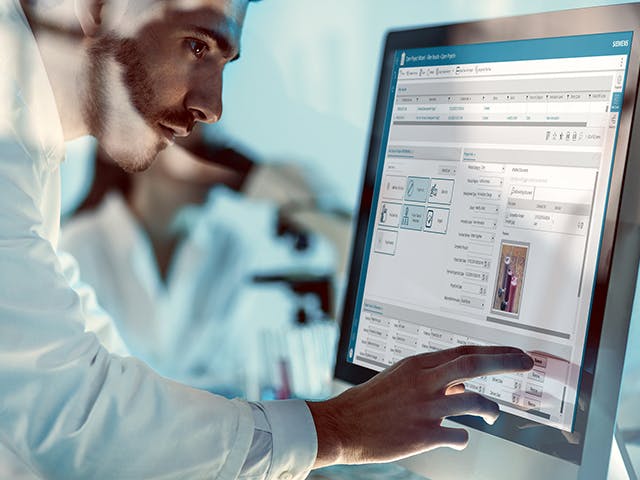Software SIMATIC IT MES
SIMATIC IT Unified Architecture Foundation (UAF) è una piattaforma per la creazione, l'esecuzione e la gestione di un moderno ecosistema MOM, mirato alle tecnologie di trasformazione attuali e future che stanno plasmando il futuro della produzione. Al centro di SIMATIC IT UAF c'è un bus dati unificato per le operazioni di produzione che fornisce una spina dorsale comune per l'integrazione di applicazioni legacy e offre anche il primo passo fondamentale verso un sistema unificato e integrato.
Le logiche SIMATIC IT UAF vengono eseguite in un ambiente di esecuzione distribuito progettato per funzionare su hardware di calcolo di piccole e grandi dimensioni. I dati vengono salvati in modo permanente in un sistema di gestione di database relazionali standard (RDBMS).
SIMATIC IT UAF è costruito attorno al domain-driven design (DDD). I dati, i servizi e gli eventi dell'applicazione sono definiti da un modello che definisce la struttura dell'applicazione ed esposti come metadati a qualsiasi livello.
SIMATIC IT UAF è dotato di un'architettura orientata ai servizi (SOA) basata su eventi. La sua applicazione è composta da blocchi funzionali modulari, dispiegati e gestiti dall'ambiente di esecuzione, intercomunicanti con eventi e messaggi. Questa architettura consente una gestione modulare delle applicazioni, facilitando così l'espansione funzionale.
SIMATIC IT UAF è progettato per scalare verso l'alto per garantire un elevato livello di prestazioni durante tutto il ciclo di vita dell'applicazione, supportando un carico crescente di utenti e dati e l'espansione a livello funzionale.
Prodotto correlato: Opcenter Execution
SIMATIC IT Unified Architecture Discrete Manufacturing
Vedere Opcenter Execution Discrete
SIMATIC IT Unified Architecture Discrete Manufacturing (UA Discrete Manufacturing) è il sistema specializzato per l'esecuzione della produzione che risponde alle esigenze del mercato dell'industria discreta. È progettato per soddisfare le esigenze dei settori in cui le macro-aree sono dedicate all'esecuzione di funzioni di produzione discreta sequenziale per produrre il prodotto desiderato. Questi includono:
- Fornitori di livello automobilistico
- Fornitori di livello aerospaziale e della difesa
- Produttori di energia e sistemi di pubblica utilità
- Produttori di macchinari industriali e attrezzature pesanti
- Produttori di elettrodomestici ed elettrodomestici
- Produzione e assemblaggio di parti complesse
- Funzioni specializzate pronte all'uso sia per la produzione di assemblaggi complessi e per gli ambienti di officina (elevata complessità, basso volume) che per le industrie manifatturiere ripetitive automatizzate (prodotti configurabili, volume elevato)
Va inoltre notato che SIMATIC IT UA Discrete Manufacturing supporta i processi di produzione additiva a letto di polvere. Ciò include la preparazione dei lotti di polvere, la frazione, il consumo, il riciclaggio e l'associazione con i certificati dei laboratori di prova, la miscelazione e la genealogia. Associa inoltre i numeri di serie ai lavori di stampa per questo spazio di produzione.
SIMATIC IT UA Discrete Manufacturing offre l'ingegneria nativa e la definizione dei dati run-time. Gli ingegneri di prodotto possono definire le entità in modo che sia possibile modellare i dati di progettazione. Ciò significa che possono configurare le informazioni sui prodotti che produrranno, il processo di produzione e le relative operazioni di lavoro e tutte le risorse necessarie, come ubicazioni, macchine, utensili, definizioni dei materiali, difetti e codici di rilavorazione. In alternativa, ovviamente, è possibile importare tali dati da sistemi esterni.
SIMATIC IT UA Discrete Manufacturing consente controlli di interblocco configurabili per convalidare l'avvio e il completamento dell'operazione e vincoli configurabili sull'uso di strumenti e attrezzature di produzione. Applica la gestione degli audit e delle certificazioni per tracciare e prevenire azioni non autorizzate. Può scaricare i setpoint sulle macchine, raccogliere i dati di processo e attivare la stampa di etichette. SIMATIC IT UA Discrete Manufacturing esegue chiamate di materiali, chiamate di utensili e rifornimento di buffer e-kanban.
SIMATIC IT Unified Architecture Process Industries
Vedere Processo di esecuzione di Opcenter
SIMATIC IT Unified Architecture Process Industries (UA Process Industries) è progettato per l'industria dei beni di consumo confezionati (CPG), degli alimenti e delle bevande e delle specialità chimiche. SIMATIC IT UA Process Industries consente di eseguire piani di produzione ben eseguiti attraverso una corretta sequenza delle operazioni di produzione e dei lavori in corso (WIP) utilizzando una gestione intuitiva delle attività. Questa capacità si traduce in una minore domanda di risorse limitate, tempi di ciclo più brevi e consegne puntuali.
Sulla base delle priorità e delle regole di produzione associate a specifiche attrezzature di produzione e caratteristiche del prodotto, SIMATIC UA Process Industries garantisce che l'attrezzatura giusta con lo stato corretto sia nel posto giusto al momento giusto. Di conseguenza, i produttori di processo sono in grado di ridurre al minimo i tempi e gli sforzi di cambio formato e/o aumentare il tempo di funzionamento delle apparecchiature. SIMATIC UA Process Industries tiene conto della capacità limitata delle risorse e, se necessario, considera operazioni parallele, sovrapposte o alternative.
SIMATIC IT UA Process Industries riporta in tempo reale le operazioni di produzione effettive e consente il confronto con i risultati attesi e storici. Oltre a fornire misurazioni delle prestazioni secondo gli standard, la conformità alla pianificazione, il tempo di ciclo dell'unità di prodotto, la disponibilità e l'utilizzo delle risorse, SIMATIC IT UA Process Industries esegue analisi che includono il controllo statistico dei processi e il controllo statistico della qualità (SPC/SQC).
SIMATIC IT eBR
Vedi Opcenter Execution Pharma
SIMATIC IT eBR è la soluzione specializzata per l'esecuzione della produzione per la gestione elettronica dei record dei lotti (eBR) utilizzata nelle scienze della vita e nell'industria farmaceutica. Offre un'integrazione nativa tra il MES e il livello del sistema di controllo distribuito (DCS). Ciò accelera le fasi di progettazione, esecuzione e revisione dell'eBR e fornisce una reale flessibilità nel processo di progettazione dei record dei masterbatch.
SIMATIC IT eBR consente di gestire tutti i processi regolamentati senza procedure o documenti cartacei. Il sistema offre una facile configurazione e funzionalità pronte all'uso e consente agli utenti di progettare qualsiasi processo senza competenze specifiche di tecnologia dell'informazione (IT).
Pienamente conforme alle normative della Food and Drug Administration (FDA) e delle buone pratiche di fabbricazione (GMP) degli Stati Uniti, il sistema ottimizza i processi di produzione in batch e aiuta a semplificare le risorse, come la guida per l'utente, l'allocazione delle apparecchiature e le procedure operative standard. Inoltre, controlla sistematicamente la corretta esecuzione di tutte le fasi, sia quelle umane che quelle controllate dal livello di automazione.
SIMATIC IT eBR consente ai produttori del settore farmaceutico e delle scienze biologiche di acquisire in modo affidabile dati di processo critici. Consente ricerche in avanti e all'indietro attraverso la genealogia e gli strumenti di audit trail. Ciò riduce significativamente i tempi di produzione, revisione e rilascio e consente un time-to-market più rapido.
SIMATIC IT eBR consente ai produttori del settore Life Sciences di raggiungere l'eccellenza operativa, accelerare il time-to-market, ridurre i costi di conformità e migliorare la qualità e la produttività. SIMATIC IT eBR aiuta le aziende a massimizzare l'efficienza di tutte le risorse – guida per l'utente, allocazione delle attrezzature e procedure operative – e a controllare e tracciare ogni operazione durante l'esecuzione della produzione, sia umana che automatizzata. Il sistema consente la revisione del record del lotto di prodotto per eccezione, fornendo un rilascio più rapido ed efficiente dei prodotti.
Alimentato da un motore di flusso di lavoro avanzato e da un concetto di istruzioni di lavoro elettroniche (EWI) di facile utilizzo, SIMATIC IT eBR può essere utilizzato per dirigere la produzione, registrando e centralizzando tutte le informazioni necessarie per la revisione del record di lotto completato, consentendo il rilascio per eccezione. La gestione dei record del lotto master (MBR) facilita i parametri chiave del processo.
SIMATIC IT R&D Suite
Vedi Opcenter Research, Development & Laboratory (RD&L)
SIMATIC IT R&D Suite semplifica i processi di ricerca e sviluppo e produzione. Consente una transizione fluida dei dati e delle definizioni di prodotto attraverso l'intero processo di produzione integrando i laboratori di ricerca e sviluppo con gli impianti.
La suite SIMATIC IT R&D mantiene la progettazione e i processi di prodotto in linea con i requisiti di qualità e normativi. Supporta funzionalità chiave come la conformità normativa e i processi di proprietà intellettuale. Le tipiche attività di ricerca e sviluppo, come la gestione dei progetti, lo sviluppo di formule e imballaggi, la gestione di prove ed esperimenti e la progettazione del processo di produzione, sono supportate da un set integrato di componenti best-in-class, tra cui notebook elettronici, gestione del laboratorio, gestione delle specifiche, gestione dei lotti e dell'inventario, produzione di impianti pilota e altro ancora.
Nella sua forma attuale, SIMATIC R&D Suite raggruppa le sue capacità in tre soluzioni modulari integrate per le attività di ricerca, sviluppo e laboratorio:
- SIMATIC IT Interspec (vedere Opcenter Specification) - Abilita un unico repository in tutto il mondo per gli impianti complessivi, contenente tutti i dettagli per tutte le materie prime, i semilavorati, i prodotti finiti e i materiali di imballaggio che sono stati utilizzati all'interno di un'azienda. Include la distinta base completa e le specifiche controllate per la versione.
- Componenti di formulazione SIMATIC IT R&D (vedi Opcenter Formulation) - Dà vita al gemello digitale del prodotto. Accede al repository unico fornito da SIMATIC IT Interspec per lavorare su una formula migliorata in ambiente digitale, partendo da una distinta base (BOM) esistente o partendo da zero. Avere il gemello digitale della formula consente agli utenti di vedere l'impatto immediato di quella formula sul costo del prodotto, sui valori nutrizionali, sugli allergeni e sulla conformità normativa (comprese le normative ovunque il prodotto venga esportato in tutto il mondo).
- SIMATIC IT Unilab (vedi Opcenter Laboratory) - Il componente LIMS (Laboratory Information Management System) è una parte fondamentale della SIMATIC IT R&D Suite. Avendo definito tutti i parametri di qualità e i componenti di gestione delle specifiche, e disponendo del gemello digitale della formula, SIMATIC IT Unilab consente al sistema di trasferire il gemello digitale in prove reali e anche di analizzare immediatamente in laboratorio per vedere come queste prove sono conformi ai parametri di qualità che vengono proposti.
Altri strumenti critici di SIMATIC IT R&D Suite includono:
Quaderno di laboratorio elettronico (ELN, Electronic Lab Notebook): fornisce funzionalità mirate per garantire che ogni ricercatore abbia la piena libertà di acquisire facilmente tutti i dati di qualsiasi tipo di esperimento o report in formato elettronico.
Workbench Formula: fornisce l'ambiente creativo per gestire un gran numero di prototipi in un workbench e supporta prove ed esperimenti per introdurre e verificare nuove formule, materie prime, materiali di imballaggio, ingredienti, progetti di processi di produzione e progetti di test.
Collaborazione con i fornitori: consente di lavorare a stretto contatto con i fornitori per la gestione dei dati di prodotto formulati. I fornitori possono accedere direttamente al sistema attraverso un portale sicuro dove possono solo visualizzare i materiali che stanno fornendo e aggiornare i campi informativi necessari. Questo strumento riduce al minimo il rischio di errori e inefficienze dovuti alla mancanza di specifiche nelle schede tecniche dei prodotti o al tempo perso per ridigitare le specifiche nel sistema.
SIMATIC IT Unified Architecture Manufacturing Intelligence
Vedi Opcenter Intelligence
SIMATIC IT Unified Architecture Manufacturing Intelligence è una moderna soluzione di enterprise manufacturing intelligence che si rivolge alle tecnologie di trasformazione attuali e future che stanno plasmando il futuro dell'analisi dei dati per il settore manifatturiero: Internet of Things, cloud computing e advanced analytics.
SIMATIC IT UA Manufacturing Intelligence connette, organizza e aggrega i dati di produzione provenienti da diverse fonti aziendali in informazioni coese, intelligenti e contestualizzate al fine di ottenere informazioni immediate e fruibili. Tali informazioni includono dati di processo combinati con informazioni aziendali, dati operativi e indicatori chiave delle prestazioni (KPI) che influiscono sulla produzione.
SIMATIC IT UA Manufacturing Intelligence offre all'utente una prospettiva d'insieme delle informazioni, fornendo strumenti per creare dashboard e report basati sul Web accessibili da qualsiasi luogo, consentendo l'esplorazione self-service dei dati e consentendo di individuare tendenze e altre relazioni tra i dati che altrimenti potrebbero non essere evidenti quando si esaminano diversi fogli di calcolo o report.
SIMATIC IT UA Manufacturing Intelligence estende la soluzione Siemens MOM fornendo la capacità di applicare tecniche di analisi e reporting alle operazioni e ai dati aziendali a livello locale, regionale e globale.
SIMATIC IT UA Manufacturing Intelligence integra, connette e unifica le fonti di dati, come il sistema di gestione delle informazioni di laboratorio (LIMS), la gestione delle risorse aziendali (ERP), il sistema di esecuzione della produzione, il sistema di gestione della qualità, la pianificazione e la programmazione avanzate e altri, in un unico modello di dati analitico accessibile che fornisce funzionalità per esplorare e approfondire i dati contestualizzati.
SIMATIC IT UA Manufacturing Intelligence viene utilizzata a livello di impianto per migliorare la collaborazione e lo scambio di dati tra l'impianto e i sistemi aziendali e/o a livello aziendale per confrontare e confrontare i cicli di produzione o prevedere le varie operazioni dell'impianto. Man mano che i dati provenienti da fonti diverse vengono combinati, possono essere inseriti in un nuovo contesto o aggregati per fornire agli utenti una prospettiva diversa e più completa delle operazioni, indipendentemente dalla provenienza dei dati.



